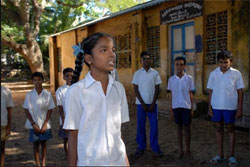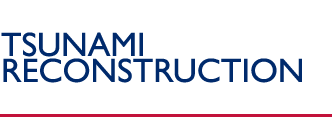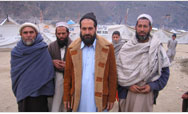USAID Rebuilds Lives After the Tsunami
Latest News

|
In December 2004, a major earthquake followed by a tsunami hit Asia and Africa, devastating many coastal areas. Almost 200,000 people in eight countries perished in a few hours, and over 100,000 are still missing. Many more had their homes and livelihoods swept away. The coastal areas of Indonesia and Sri Lanka and two Indian island chains bore the brunt of the calamity. They will require significant repair and reconstruction.
USAID's historic commitment to these countries, 40 years of expertise with disaster assistance, and solid working relationships with the region's governments meant we were able to respond immediately, providing life-saving food, water, medical care and shelter.
Now, standing side-by-side with the survivors, we are rebuilding communities and lives. Our cash-for-work programs give families incomes. Loans, business advice and training in job skills help develop new businesses and sources of income. Longer-term projects to reconstruct water systems, roads and other critical systems are underway. The success of our work is a testament to the resilience of the human spirit, learning from experience and the power of partnerships between nations.
| Total USG Humanitarian and Recovery Assistance Pledged 12/31/04: | $350,000,000 |
| Tsunami Recovery and Reconstruction Fund: | $656 million* |
| India: | $17.9 million |
| Indonesia: | $405.7 million |
| Maldives: | $ 12.0 million |
| Sri Lanka: | $134.6 million |
| Thailand: | $5.3 million |
| Regional, other countries: | $31.8 million |
| Program Management: | $17.4 million |
| *$656 million was approved for the Tsunami Recovery and Reconstruction Fund, but $31.3 million is
committed to Avian Flu. |
10/09/07: Reconstruction Update - December 2007 (PDF - 395kb)
TSUNAMI RECONSTRUCTION HIGHLIGHTS
India
MAKING HEADLINES AND CHANGE: CHILDREN’S PARLIAMENT IN CUDDALORE
 In August, a widely read southern Indiannewspaper, the DhinaThanthi,published a story about a prime minister who overturned the disparity in government scholarships for students in the tsunami-affected areas of Cuddalore, a city outside of Chennai. The prime minister’s actions were notable: she influenced teachers, the municipal council, and government leaders to make the scholarships available to schools in her region. However, the prime minister made headlines because she herself is a student at one of the schools in Cuddalore. Eskomola Sundaray is just 13 years old and leads a children’s parliament that was initiated by USAID. In August, a widely read southern Indiannewspaper, the DhinaThanthi,published a story about a prime minister who overturned the disparity in government scholarships for students in the tsunami-affected areas of Cuddalore, a city outside of Chennai. The prime minister’s actions were notable: she influenced teachers, the municipal council, and government leaders to make the scholarships available to schools in her region. However, the prime minister made headlines because she herself is a student at one of the schools in Cuddalore. Eskomola Sundaray is just 13 years old and leads a children’s parliament that was initiated by USAID.
“In my position, I am doing so much. In the position of public or government minister, I would want them to do the same work which I am doing. Now we are aware of what they are supposed to do and how that should be done,”she said.
Eskomola is halfway through her year-long term as the democratically elected prime minister of the district’s first children’s parliament, which includes eight other ministers and a total of 20 members. The parliament—one of hundreds across several tsunami-affected districts—is part of the Suraksha(“Future”) program, an evolution of the Bavishia(“Transition”) programs for children’s recovery that were instituted following the 2004 tsunami.
Over the past three years, USAID has provided trauma counseling and back-to-school initiatives, as well as children’s libraries, parks, puppet shows, and street plays. The programs that began in the summer of 2007 center on psychosocial care, health and hygiene, and children’s rights.
Thailand
USAID-SUPPORTED MICROFINANCE FUND JOINS NATIONAL CREDIT UNION
A USAID-financed microfinance fund in a tiny, tsunami-ravaged village has proven so successful that it has been accepted as an associate member of the Credit Union League of Thailand.
Launched through USAID’sSustainable Coastal Livelihoods program, the Ban Kamphuanrevolving-funds group has provided over 7.8 million baht (around $240,000) in loans since 2005 to help 416 families rebuild their livelihoods. The payback rate is nearly 100 percent, demonstrating the creditworthiness of the poor, a group traditionally excluded from credit.
As an approved cooperative, the credit union can now provide insurance, savings accounts, and money to help support the elderly and the infirm.
Regional
NEW INDIAN OCEAN WARNING SYSTEM SOUNDS ALERT FOR TSUNAMIS
The tsunami that struck the Indian Ocean region in December 2004 caught hundreds of thousands of people off guard and cost them their lives. Within months, work began on a multinational warning system designed to relay reports of an undersea earthquake—and potential tsunami—to country officials who can pass the warning on to everyone in the storm’s expected path.
The two-year, $16.6 million U.S. Indian Ocean Tsunami Warning System (IOTWS) program is being implemented by a USAID-led consortium of five U.S. government agencies in support of the Intergovernmental Oceanographic Commission (IOC), part of the United Nations, which leads the international effort. More than 100 U.S.-funded experts and scientists worked on the project.
With many critical components in place by 2007, the system has already been put to use. When an 8.2-magnitude earthquake off the coast of Sumatra, Indonesia, on September 12, sensors provided information within seconds, and international tsunami bulletins were issued minutes after the earthquake. National warning systems sprang into action, analyzing data and risk, issuing warnings, and—just as important—cancelling them. Local communities responded by remaining alert or evacuating, depending on the assessed level of risk.
The plan was to design an “end-to-end”tsunami and multi-hazard warning system for the 28 countries in the Indian Ocean region. That meant that the system needed to take into account everything from the initial detection of an earthquake and tsunami at sea, to the processing of data, the dissemination of warning information, and the preparation of local communities for rapid response.
The United States provided the initial design for the regional warning system and provided critical equipment, including coastal sea-level gauges, seismic stations, enhanced communications systems, and two deep-ocean tsunami detectors, known as “tsunameters”or DART (Deep-Ocean Assessment and Reporting of Tsunamis) buoys.
U.S. experts also assisted in setting up national disaster warning centers in Indonesia, Thailand, Sri Lanka, and the Maldives, and they provided training to government specialists. Tens of thousands of people have participated in disaster training sessions, evacuation drills, and other community-focused interventions as part of USAID’sefforts to increase community resilience in tsunami-vulnerable areas.
Indonesia
ACEH’S NEW COFFEE GROWERS
Nasrun, a father of four from the village of Towerenin central Aceh, is now confident about his future in the coffee business. He has 1.5 hectares of the crop under cultivation. A recent harvest, sold through the USAID-supported local cooperative KoperasiBaitulQuirahBaburayon(KBQB), netted him $200.
Besides selling his own coffee, Nasrunalso collects the yields from other area coffee farmers and sells that coffee to the cooperative. During the civil conflict that preceded the tsunami, it was unsafe to work the land and Nasrunlost his only source of income. The farm went untended for four years. Nasruntook odd jobs to support his family, but there were many hungry nights.
Through his participation in the USAID-supported Farm Rehabilitation program, he has been able to work his farm again and to produce a high-quality organic Arabica coffee. “I feel so happy to have my coffee plantation back. I plan to increase my coffee production so that I can enhance my income!”
Najifah is a successful coffee farmer with a 1.5 hectare plot in the central highlands of Aceh. She became a member of the KBQB cooperative two years ago. Her husband helps sell her coffee to KBQB. This season, KBQB purchased her coffee at a good price, earning her $250. “I will use this money for my children’s education, so that they will be smart,” Najifah said. “Not a farmer like me.”
These farmers and KBQB members are part of a group of more than 6,600 farmers cultivating small plots throughout 36 districts of Aceh. As a result of USAID assistance, all of the coffee produced by these farmer-members has successfully passed organic inspections by programs of the USDA, the European Union, and Japan. The farms have also been approved by the Starbucks Coffee CAFÉPractices certification program, and the overall program has obtained Fair Tradecertification.
Sri Lanka
USAID SMALL GRANTS MAKE BIG IMPACT ON SRI LANKAN COMMUNITIES
Days after the tsunami, USAID’s Transition Initiatives program was among the first to deliver to emergency relief and livelihoods assistance. Through cash-for-work activities, the program mobilized communities to clean up tons of debris, and it put money back into pockets of affected families.
As the third anniversary of the tsunami passes, more than 95 percent of the funds have been committed to nearly 300 small grants; 225 have already been completed, and the remainder will be complete by mid-2008. The program builds on successful past grant programs in order to achieve sustained impact in targeted communities.
In Batticaloa, for example, a series of grants restored the historic tsunami-damaged lighthouse and environs to improve the livelihoods of up to 20,000 Tamil and Muslim fishermen as well as to attract tourists to the district, which is among the most conflict-and tsunami-affected in the country. The grants also included a training and consultation component for fishermen, including sessions on environmental protection.
TSUNAMI-AFFECTED COMMUNITIES UNITE TO HELP THEMSELVES
Despite the last three years of hard work, collaboration, and cooperation among communities, local and national governments, and the international community, many challenges still remain for the survivors of the December 2004 Indian Ocean tsunami.
One of those challenges is informing those affected by the tsunami about the successes achieved in the recovery and reconstruction of their communities. Regrettably, local media coverage and political rhetoric often focuses on the failures and delays in the rehabilitation efforts and neglects the achievements.
To demonstrate the potential of people working together and to celebrate the steps individuals have taken to rebuild their lives, USAID’sTransition Initiatives program gathered several neighboring communities along Sri Lanka’s southern coast for evenings of cultural entertainment and facilitated dialogue.
Organizers trucked giant mobile screens from village to village to display video footage of fellow citizens who overcame obstacles to regain normal lives and improve their livelihoods after the tsunami. Throughout the presentation, live “microphoned” moderators encouraged audience members to contribute their own survival stories of hope and hardship, cultivating an environment of support, achievement, and community bonding.
ARUGAM BAY BRIDGE PASSES HALFWAY POINT WITH ARRIVAL OF GIRDERS
The USAID Sri Lanka Tsunami Reconstruction Program (SLTRP) contractor CH2M Hill has reported that the ArugamBay Bridge project is 54 percent complete.
Vertical columns are in place, and steel girders providing a span of 185 meters have arrived from Indonesia. Installation of a complementary water supply system in the immediate area is also making good progress and, like the bridge, is scheduled for completion in 2008.
USAID REHABILITATES PARK IN SOUTHERN PROVINCE CAPITAL
USAID recently dedicated a rehabilitated park in Galle, the capital of Sri Lanka’sSouthern Province. The park complements a previous project to install a children’s playground in the tsunami-damaged area as part of USAID’scomprehensive play parks initiative.
This year, another project upgraded the rest of the park facilities with a new amphitheater, ponds, fountains, food services, an information booth, and sanitary facilities. Together, these projects will improve the park’s safety and functionality as a gathering place for residents and tourists. The projects also supported the formation of a park association to manage and maintain the new facilities.
Back to Top ^
|


